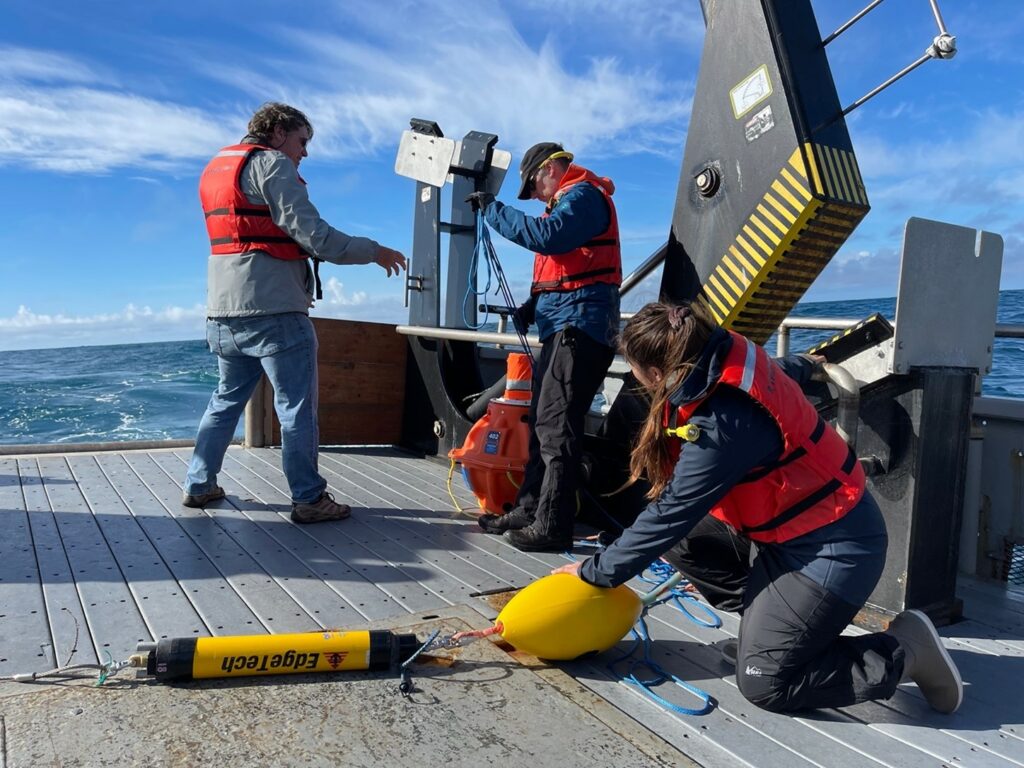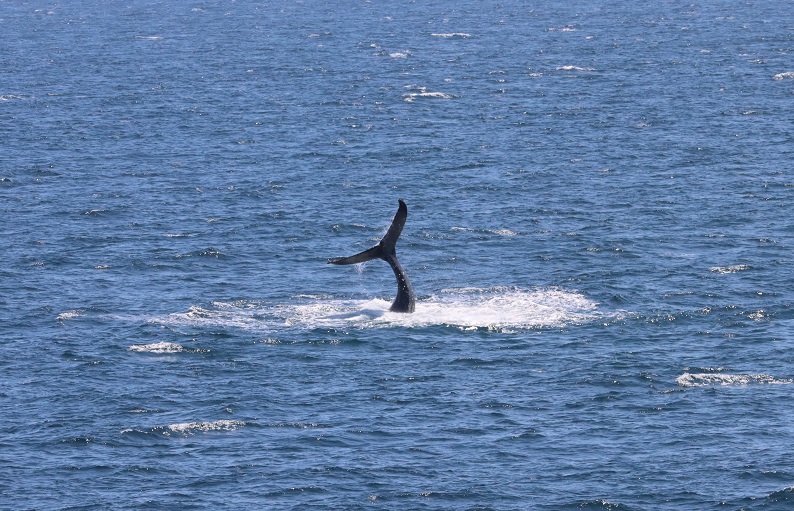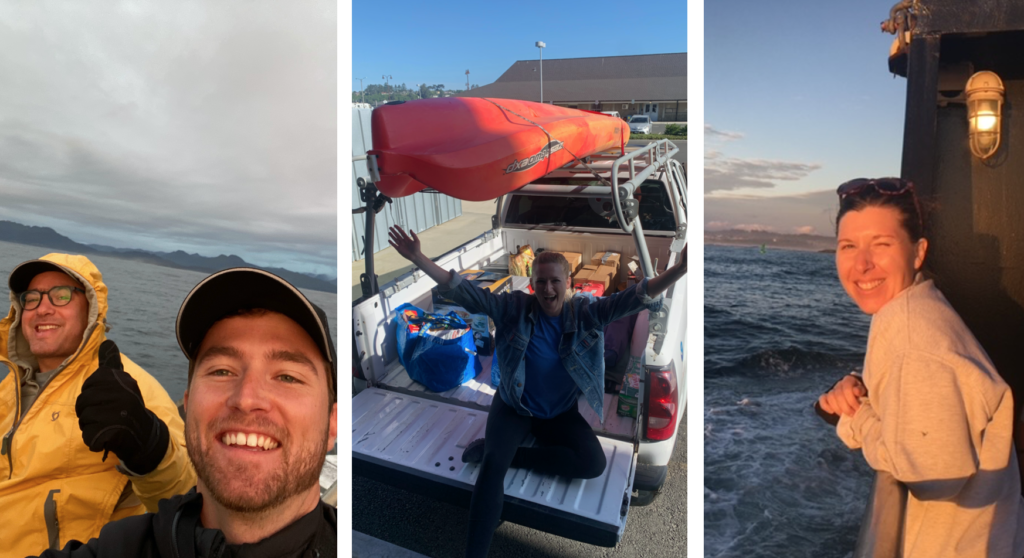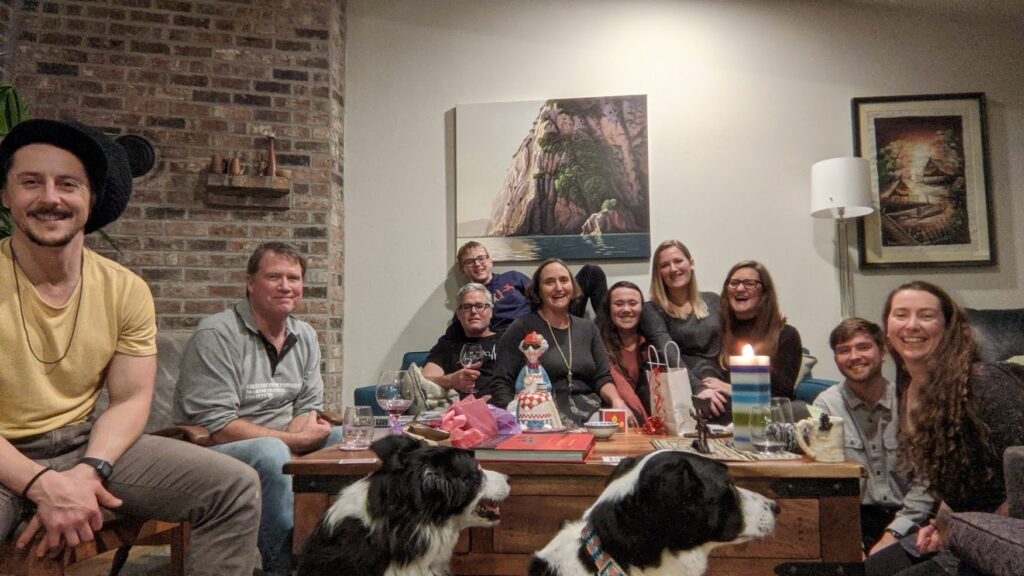Another year has come and gone, and the GEMM Lab has expanded in many facets! Every year it gets just a little bit harder to succinctly summarize all of the research, outreach, and successes that the GEMMs accomplish but it is an absolute honor and thrill to be a member of this lab. So, please enjoy the 6th edition of a GEMM Lab Year in the Life!
Our lab has almost doubled in size since I wrote the 2020 edition of this blog! This year we welcomed the arrival of two postdocs (Drs. Alejandro [Ale] Fernández Ajó and KC Bierlich) and two Master’s students (Allison Dawn and Miranda Mayhall). Ale and KC joined us as freshly minted Drs., as Ale defended his doctoral thesis from Northern Arizona University in April, while KC graduated in May from Duke University. Both of them immediately jumped into GRANITE fieldwork, scooping gray whale poop and flying drones (more below). Allison also dove headfirst into gray whale fieldwork as she co-led the TOPAZ and JASPER projects with me (Lisa) after defending her undergraduate thesis and graduating from the University of North Carolina with highest honors in the spring. Miranda, a U.S. Army Intelligence veteran, also joins us from the East Coast as she moved from Virginia to Oregon with her 10-year-old daughter, Mia, and two dogs, Angus and Mr. Gibbs. Unlike our other new arrivals, Miranda’s research does not relate to gray whales as she is part of the GEMM Lab’s newest research project…
There are exciting developments in the research project realm of the GEMM Lab every year. This year’s new project, HALO (Holistic Assessment of Living marine resources off Oregon), is particularly exciting as it is a joint project with the Cornell Lab, with GEMM Lab PI Leigh collaborating with Dr. Holger Klinck to better understand cetacean distributions off Oregon. HALO will involve monthly survey cruises aboard MMI’s R/V Pacific Storm along the Newport Hydrographic line (65 nm to 5 nm off Newport), where three Rockhopper hydrophones have been deployed and are passively monitoring cetacean acoustics. The HALO team, which includes GEMM students Miranda and PhD candidates Dawn Barlow and Rachel Kaplan, has already had two successful cruises this year! Check out the HALO website to stay tuned for updates throughout 2022. In addition to starting new research projects in our Oregon backyard, the GEMM Lab has also ventured further north, to the more frigid waters of Kodiak, Alaska. Postdocs KC and Ale went on a scouting mission to Kodiak Island to see whether the multidisciplinary methods we use in the GRANITE project to study PCFG gray whales in Oregon, can also be applied to other gray whales in other study areas. The reconnaissance trip was a huge success with KC and Ale making vital connections with potential collaborators and managing to collect some pilot data (drone flights, prey samples, and one fecal sample!). Both of these new ventures are funded by sales and renewals of the special Oregon gray whale license plate, which benefits MMI. We gratefully thank all the gray whale license plate holders, who made this research possible, and encourage any Oregonians that don’t have a whale on their tale yet, to do so in 2022!





These new research ventures certainly do not mean that we neglected our already established field research projects – in fact, most of them have flourished and thrived this year! Rachel and Dawn returned as marine mammal observers to the R/V Shimada for the May stint of the Northern California Current research cruise. They observed Dall’s porpoise, Northern right whale & Pacific white-sided dolphins, as well as killer, humpback, & fin whales. These sightings will add to the growing OPAL (Overlap Predictions About Large whales) dataset that both Rachel and postdoc Solène Derville are analyzing to better understand whale distribution patterns in Oregon waters. Speaking of OPAL, MMI Faculty Research Assistant Craig Hayslip and Leigh continued to take to the skies in U.S. Coast Guard helicopters to obtain monthly cetacean distribution data, which is also being used in the OPAL project to identify the co-occurrence between whales and fishing effort in Oregon to reduce entanglement risk. Both of our gray whale projects, GRANITE (Gray whale Response to Ambient Noise Informed by Technology & Ecology) and TOPAZ (Theodolite Overlooking Predators & Zooplankton)/JASPER (Journey for Aspiring Scientists Pursuing Ecological Research) had another year of successful field seasons. The GRANITE team, which includes Leigh, Todd Chandler, Ale, KC, PhD student Clara Bird, and myself, headed out in search of gray whales earlier than usual this year to document the potential effects of a National Science Foundation (NSF) funded seismic survey, which was conducted off the Oregon coast, on gray whales in the area. By the end of October, we had conducted 80 drone flights, collected 48 and 66 fecal and prey samples (respectively), and seen 36 individual whales during 201 sightings. Down south in Port Orford, the TOPAZ/JASPER project experienced a passing of the torch as I stepped down from the team lead position (which I held since 2018) and handed the project reins over to Allison. We co-led another fantastic field season this year. While whale sightings were much lower than in previous years (read some musings here), the project continued to be successful at making real impacts on young people’s lives as we once again engaged a local Pacific High School student (Damian Amerman-Smith) and two OSU undergraduates (Nadia Leal & Jasen White) in the field work. While our annual reach may be small in terms of numbers, the impact we have is huge, with many of the high school interns (including this year’s) deciding to go to college and/or to study biology directly as a result of our project.




TOPAZ/JASPER certainly is not the only project in our lab that engages students in ecological research. This year, we collectively oversaw and mentored 13 students. The OBSIDIAN (Observing Blue whale Spatial ecology to Investigate Distribution In Aotearoa New Zealand) project was assisted by three interns (Grace Hancock, Mateo Estrada Jorge, and Mattea Holt Colberg) overseen by Dawn and Leigh. Grace worked on maintaining the New Zealand blue whale photo-ID catalogue and won best student poster at our department’s annual student conference (RAFWE) for this work. Mattea, a 2020 TOPAZ/JASPER team member, switched study species and assisted Dawn in validating blue whale calls and songs. Mateo was a NSF Research Experience Undergraduate (REU) who conducted an analysis on blue whales and earthquakes. Clara also supervised a REU student with Leigh: Marc Donnelly, who created a habitat map for the GRANITE project. Rachel mentored Amanda Kent, an Undergraduate Research, Scholarship, & the Arts (URSA) Engage student, who helped her conduct a literature review about two Oregon krill species that are primary prey of whales. Over the summer, we had two student workers (Noah Goodwin-Rice & Julia Parker) join us in our efforts to better understand gray whale prey. Noah assisted us by sorting and identifying gray whale prey samples collected this summer and Julia wrapped up the microplastics analysis of gray whale prey and fecal samples. In the fall, both Clara and Allison supervised students (Kathryne Macallan & Jasen White, respectively) taking the Coastal & Estuarine Research Management class in our department who produced independent research projects during the term. Kathryne investigated the relationship between body length and blow intervals of gray whales during different behavioral states, while Jasen dove into the relationship between zooplankton abundance and environmental covariates.
The sharing of our research and expertise was not limited to mentoring students. Despite most conferences and seminars still occurring virtually this year due to the pandemic, the GEMM Lab presented numerous talks including at the State of the Coast (Rachel, Dawn, Leigh, & myself), International Biologging Symposium (Solène), HMSC Research Seminar (Ale & Solène, KC), and the Northwest Student Society of Marine Mammalogy chapter conference (Clara, Dawn, & myself), to name a few. Furthermore, Clara and I were guest lecturers once again for Dr. Renee Albertson’s marine mammal classes in our department, and Solène gained her first teaching experience by creating and leading a data visualization workshop (called “Pimp my figure!”) for RAFWE in May, which she reiterated at the University of New Caledonia in October.
Another huge accomplishment comes from the southern hemisphere as the hard work and time that Leigh and Dawn dedicated to OBSIDIAN and the results generated contributed to the denial of a seabed mining permit to extract iron sands in the South Taranaki Bight. This milestone has been years in the making, starting in 2013 when Leigh published her hypothesis that an unrecognized blue whale foraging ground existed in New Zealand. Since then, Leigh and Dawn have been building a tower of knowledge about these resident New Zealand blue whales block-by-block. They first confirmed Leigh’s hypothesis by presenting a bounty of evidence in support of this resident population, then assessed the skin condition of these whales, modeled the functional relationships between oceanography, krill and the distribution of blue whales, discovered temporal and spatial lags between wind, coastal upwelling, and blue whale occurrence, and most recently, developed dynamic models to forecast blue whale distribution three weeks into the future. We are extremely proud of the direct applications that the OBSIDIAN research outputs have had on the management and conservation of these New Zealand blue whales – hurrah to Leigh & Dawn!!
Other hurrahs this year include that Rachel passed her College of Earth, Ocean, & Atmospheric Sciences qualifying exam, now making her a PhD Candidate. Clara also reached a graduate milestone this year as she not only formed her PhD committee but also successfully defended her research review in the spring. Additionally, Clara became a certified drone pilot right before the start of the GRANITE field season and joined Todd and KC as pilots this summer. The lab and its members also received numerous grants and awards. There are too many to name for this blog, but we are very grateful for all of them! I do want to highlight two here: Dawn was awarded the Bob Moch memorial endowment award that recognizes service to the Hatfield Marine Science Center (HMSC) and broader Oregon coast community. I cannot think of anyone more deserving of this award than Dawn who truly does so much to serve and better the HMSC and Oregon coast communities! Clara was awarded a prestigious ARCS (Achievement Rewards for College Scientists) scholarship which provides awards to academically outstanding students to further their scientific knowledge.
We have once again been prolific writers, contributing 24 total peer-reviewed publications to 17 different scientific journals. If you are in the mood for some holiday reading, you will find the full list of publications at the end of this post.
And YOU, our awesome, supportive readers, have once again been supportive viewers, with a whopping 27,135 views of our blog this year!!! Thank you for joining us on our 2021 journey! We hope you have enjoyed the tales that we have told and the knowledge we have (hopefully) conveyed. We wish you all restful, happy, and most importantly, healthy holidays and hope you will join us again in 2022!
Did you enjoy this blog? Want to learn more about marine life, research, and conservation? Subscribe to our blog and get weekly updates and more! Just add your name into the subscribe box on the left panel.
Publications
Andréfouët, S., Derville, S., Buttin, J., Dirberg, G., Wabnitz, C.C.C., Garrigue, C., & Payri, C. E. 2021. Nation-wide hierarchical and spatially-explicit framework to characterize seagrass meadows in New Caledonia, and its potential application to the Indo-Pacific. Marine Pollution Bulletin 173:113036. https://doi.org/10.1016/j.marpolbul.2021.113036.
Barlow, D.R., & Torres, L.G. 2021. Planning ahead: Dynamic models forecast blue whale distribution with applications for spatial management. Journal of Applied Ecology. (Link)
Barlow, D.R., Klinck, H., Ponirakis, D., Garvey, C., & Torres, L.G. (2021). Temporal and spatial lags between wind, coastal upwelling, and blue whale occurrence. Scientific Reports 11(1):1-10. (Link)
Beal, M., … Torres, L.G., et al. 2021. Global political responsibility for the conservation of albatrosses and large petrels. Science Advances 7(10):eabd7225.
Bierlich, K.C., Schick, R.S., Hewitt, J., Dale, J., Goldbogen, J.A., Friedlaender, A.S., & Johnston D.J. 2021. A Bayesian approach for predicting photogrammetric uncertainty in morphometric measurements derived from UAS. Marine Ecology Progress Series. DOI: https://doi.org/10.3354/meps13814
Bierlich, K.C., Hewitt, J., Bird, C.N., Schick R.S., Friedlaender, A.S., Torres, L.G., Dale, J., Goldbogen, J.A., Read, A., Calambokidis J., & Johnston, D.W. 2021. Comparing uncertainty associated with 1-, 2-, and 3D aerial photogrammetry-based body condition measurements of baleen whales. Frontiers in Marine Science 8:749943. doi: 10.3389/fmars.2021.749943
Bonneville, C.D., Derville, S., Luksenburg, J.A., Oremus, M., Garrigue, C. 2021. Social structure, habitat use and injuries of Indo-Pacific Bottlenose Dolphins (Tursiops aduncus) reveal isolated, coastal, and threatened communities in the South Pacific. Frontiers in Marine Science 8:1–14. https://doi.org/10.3389/fmars.2021.606975.
Clatterbuck, C.A., Lewison, R.L., Orben, R.A., Ackerman, J.T., Torres, L.G., Suryan, R.M., Warzybok, P., Jahncke, J., & Shaffer, S.A. 2021. Foraging in marine habitats increases mercury concentrations in a generalist seabird. Chemosphere 279:130470.
D’Agostino, V.C., Fernandez, A.A.A., Degrati M., Krock, B., Hunt, K.E., Uhart, M.M., & Buck, C.L. 2021. Potential endocrine correlation with exposure to domoic acid in Southern Right Whale (Eubalaena australis) at the Península Valdés breeding ground. Oecologia 1-14.
Dillon, D., Fernandez, A.A.A., Hunt, K.E., & Buck, C.L. 2021. Investigation of keratinase digestion to improve steroid hormone extraction from diverse keratinous tissues. General and Comparative Endocrinology 309:113795.
Fernandez, A.A.A., Hunt, K.H., Sironi, M., Uhart, M., Rowntree, V., Giese, A.C., Maron, C.F., DiMartino, M., Dillon, D., & Buck, C.L. 2021. Retrospective analysis of the lifetime endocrine response of southern right whales calves to gull wounding and harassment: a baleen hormone approach. Integrative and Comparative Biology 61.
Fernandez, A.A.A., Hunt, K.E., Dillon, D., Uhart, M., Sironi, M., Rowntree, V., & Buck, C.L. 2021. Optimizing hormone extraction protocols for whale baleen: tackling questions of solvent: sample ratio and variation. General and Comparative Endocrinology 113828.
Garrigue, C., & Derville, S. 2021. Behavioral responses of humpback whales to biopsy sampling on a breeding ground : the influence of age-class , reproductive status , social context , and repeated sampling. Marine Mammal Science 1–16. https://doi.org/10.1111/mms.12848.
Gough, W.T., Smith, H.J., Savoca, M.S., Czapanskiy M.F., Fish, F.E., Potvin, J., Bierlich, K.C., Cade, D.E., Di Clemente, J., Kennedy, J., Segre, P., Stanworth, A., Weir, C., & Goldbogen, J.A. 2021. Scaling of oscillatory kinematics and Froude efficiency in baleen whales. Journal of Experimental Biology224(13):jeb237586. DOI: https://doi.org/10.1242/jeb.237586
Hildebrand, L., Bernard, K.S., & Torres, L.G. 2021. Go gray whales count calories? Comparing energetic values of gray whale prey across two different feeding grounds in the eastern North Pacific. Frontiers in Marine Science, https://doi.org/10.3389/fmars.2021.683634
Jones, D.C., Ceia, F.R., Murphy, E., Delord, K., Furness, R.W., Verdy, A., Mazloff, M., Phillips, R.A., Sagar, P.M., Sallée, J-B., Schreiber, B., Thompson, D.R., Torres, L.G., Underwood, P.J., Weimerskirch, H., & Xavier J.C. 2021. Untangling local and remote influences in two major petrel habitats in the oligotrophic Southern Ocean. Global Change Biology 27(22):5773-5785.
Kone, D.V., Tinker, M.T., & Torres, L.G. 2021. Informing sea otter reintroduction through habitat and human interaction assessment. Endangered Species Research 55:159-176.
Lemos, L.S., Olsen, A., Smith, A., Burnett, J.D., Chandler, T.E., Larson, S., Hunt, K.E., & Torres, L.G. 2021. Stressed and slim or relaxed and chubby? A simultaneous assessment of gray whale body condition and hormone variability. Marine Mammal Science.
Lemos, L.S., Haxel, J.H., Olsen, A., Burnett, J.D., Smith, A., Chandler, T.E., Nieukirk, S.L., Larson, S.E., Hunt, K.E., & Torres, L.G. 2021. Sounds of stress: assessment of relationships between ambient noise, vessel traffic, and gray whale stress hormone. Scientific Reports. DOI:10.21203/rs.3.rs-923450/v1
Maron, C.F., Lábaque, M.C., Beltramino L., DiMartino, M., Alzugaray, L., Ricciardi, M., Fernandez, A.A.A., Adler, F.R., Seger, J., Sironi, M., Rowntree, V.J., & Uhart, M.M. 2021. Patterns of blubber fat deposition and evaluation of body condition in growing southern right whale calves (Eubalaena australis). Marine Mammal Science. DOI: 10/1111/mms.12818.
Orben, R.A., Adams, J., Hester, M., Shaffer, S.A., Suryan, R.M., Deguchi, T., Ozaki, K., Sato, F., Young, L.C., Clatterbuck, C., Conners, M.G., Kroodsma, D.A., & Torres, L.G. 2021. Across borders: External factors and prior behavior influence North Pacific albatross associations with vessel traffic. Journal of Applied Ecology.
Savoca, M.S. Czapanskiy, M.F., Kahane-Rapport, S.R., Gough, W.T., Falhbusch, J.A., Bierlich, K.C., Segre, P.S., Di Clemente, J., Penry G.S., Wiley, D.N., Calambokids, J.,
Nowacek, D.P., Johnston, D.W., Pyenson, N.D., Friedlaender, A.S., Hazen, E.L., & Goldbogen, J.A. 2021. Baleen whale prey consumption based on high-resolution foraging measurements. Nature 599:85–90. https://doi.org/10.1038/s41586-021-03991-5
Stephenson, F., Hewitt, J.E., Torres, L.G., Mouton, T.L., Brough, T., Goetz, K.T., Lundquist, C.J., MacDiarmid, A.B., Ellis, J., & Constantine, R. 2021. Cetacean conservation planning in a global diversity hotspot: dealing with uncertainty and data deficiencies. Ecosphere 12(7):e03633.
Thompson, D.R., Goetz, K.T., Sagar, P.M., Torres, L.G., Kroeger, C.E., Sztukowski, LA., Orben, R.A., Hoskins, A.J., & Phillips, R.A. 2021. The year-round distribution and habitat preferences of Campbell albatross (Thalassarche impavida). Aquatic Conservation: Marine and Freshwater Ecosystems 31(10):2967-2978.




